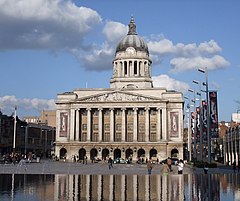Nottingham Council House
| Nottingham Council House | |
|---|---|

Nottingham Council House, Old Market Square
|
|
| General information | |
| Type | Municipal Headquarters |
| Architectural style | Neo-Baroque |
| Classification | Grade II* listed building |
| Location | Nottingham, England, United Kingdom |
| Coordinates | 52°57′12″N 01°08′55″W / 52.95333°N 1.14861°WCoordinates: 52°57′12″N 01°08′55″W / 52.95333°N 1.14861°W |
| Construction started | 1927 |
| Completed | 1929 |
| Client | Nottingham Corporation |
| Design and construction | |
| Architect | Thomas Cecil Howitt |
Nottingham Council House is the city hall of Nottingham, England. The iconic 200 feet (61 m) high dome that rises above the city is the centrepiece of the skyline and presides over the Old Market Square(also referred to as the City Center).
The Council House was designed by Thomas Cecil Howitt and built between 1927 and 1929 in the Neo-Baroque style characterised by the huge pillars that circle the building along with the carvings on the facade. It replaced the former Nottingham Exchange.
Housed within the dome the affectionately-nicknamed ‘Little John’ hour bell – for many years the deepest toned clock bell in the United Kingdom, weighing over 10 tonnes (10 t) – whose strike can be heard for a distance of seven miles.
The foundation stone (behind the left-hand lion as you approach the building) was laid by Alderman Herbert Bowles (Chairman of the Estates Committee), on 17 March 1927. The building was officially opened by the Prince of Wales (later King Edward VIII and the Duke of Windsor) on 22 May 1929. The total cost of the building at the time was £502,876 (equivalent to £27,570,000 in 2015). By the time the bill was finally cleared in 1981, the total including interest was £620,294.
The building has staged many high profile occasions; royalty, statesmen and women and stars of the stage and screen have been entertained there and both the F.A. and European Cups have been held aloft from its balcony.
Since Nottingham City Council relocated councillors’ offices to Loxley House in 2010, the Council House is seldom used for day-to-day administrative functions. From April 2011, the building also now serves as the chief Register Office for Births, Marriages and Deaths in the City.
The Council House and Exchange Buildings (to the rear) are constructed of Portland Stone from the same quarry used by Sir Christopher Wren for St. Paul's Cathedral in London. The keystone of the central arch in the entrance arcade was salvaged from a London church after the Great Fire of 1666, but lay unused for centuries on a Dorset beach.
...
Wikipedia
